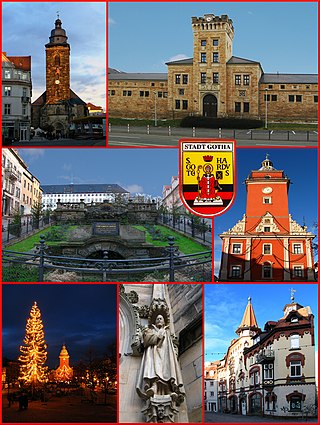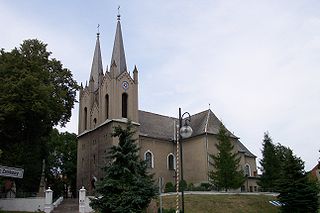Nienburg is a district (Landkreis) in Lower Saxony, Germany. It is bounded by the districts of Diepholz, Verden, Heidekreis, Hanover and Schaumburg, and by the state of North Rhine-Westphalia.

Saxe-Coburg and Gotha, or Saxe-Coburg-Gotha, was an Ernestine, Thuringian duchy ruled by a branch of the House of Wettin, consisting of territories in the present-day states of Thuringia and Bavaria in Germany. It lasted from 1826 to 1918. In November 1918, Charles Edward, Duke of Saxe-Coburg and Gotha, was forced to abdicate. In 1920, the northern part of the duchy was merged with six other Thuringian free states to form the Free State of Thuringia: Saxe-Weimar-Eisenach, Saxe-Altenburg and Saxe-Meiningen, Schwarzburg-Rudolstadt and Schwarzburg-Sondershausen, as well as the People's State of Reuss. The southern part of the duchy, as southernmost of the Thuringian states, was the only one which, after a referendum, became part of the Free State of Bavaria.

Saxe-Meiningen was one of the Saxon duchies held by the Ernestine line of the Wettin dynasty, located in the southwest of the present-day German state of Thuringia.

Gotha is the fifth-largest city in Thuringia, Germany, 20 kilometres west of Erfurt and 25 km east of Eisenach with a population of 44,000. The city is the capital of the district of Gotha and was also a residence of the Ernestine Wettins from 1640 until the end of monarchy in Germany in 1918. The House of Saxe-Coburg and Gotha originating here spawned many European rulers, including the royal houses of the United Kingdom, Belgium, Portugal and Bulgaria.

Frederick Louis, Prince of Hohenlohe-Ingelfingen was a Prussian general.

Ohrdruf is a small town in the district of Gotha in the German state of Thuringia. It lies some 30 km southwest of Erfurt at the foot of the northern slope of the Thuringian Forest. The former municipalities Crawinkel, Gräfenhain and Wölfis were merged into Ohrdruf in January 2019.

The Erfurt Union was a short-lived union of German states under a federation, proposed by the Kingdom of Prussia at Erfurt, for which the Erfurt Union Parliament, lasting from March 20 to April 29, 1850, was opened at the former Augustinian monastery in Erfurt. The union never came into effect, and was seriously undermined in the Punctation of Olmütz under immense pressure from the Austrian Empire.

The House of Hohenlohe is a former German princely dynasty. It ruled an immediate territory within the Holy Roman Empire which was divided between several branches. The Hohenlohes became imperial counts in 1450. The county was divided numerous times and split into several principalities in the 18th century.

Günthersleben-Wechmar is a former municipality in the German state (Bundesland) of Thuringia in the district of Gotha. Since July 2018, it is part of the municipality Drei Gleichen. The village of Wechmar is notable for having been the home of the Bach family of musicians and composers.

Ujazd is a town in Strzelce County in the Opole Voivodeship in southern Poland. Population 1,647.

Emil von Sydow was a German military officer, geographer and cartographer born in Freiberg, Saxony.

Princess Victor of Hohenlohe-Langenburg was a British-born aristocrat whose marriage to a German prince naturalised in England made her a kinswoman of the British Royal Family and a member of the royal court.

Drei Gleichen is a municipality in the district of Gotha, in Thuringia, Germany. It was formed on 1 January 2009 by the merger of the former municipalities Grabsleben, Mühlberg, Seebergen and Wandersleben. Since May 1992, these municipalities had cooperated in the VerwaltungsgemeinschaftDrei Gleichen. This Verwaltungsgemeinschaft was disbanded on 1 January 2009. It is named after the drei Gleichen castles between Gotha and Erfurt. In July 2018 the former municipality of Günthersleben-Wechmar was merged into Drei Gleichen.

The Principality of Erfurt was a small state in modern Thuringia, Germany, that existed from 1807 to 1814, comprising the modern city of Erfurt and the surrounding land. It was subordinate directly to Napoleon, the Emperor of the French, rather than being a part of the Confederation of the Rhine. After nearly 3 months of siege, the city fell to Prussian, Austrian and Russian forces. Having mainly been Prussian territory before the Napoleonic Wars, most of the lands were restored to Prussia by the Congress of Vienna.

Victor I, Duke of Ratibor, Prince of Corvey, Prince of Hohenlohe-Schillingsfürst was a member of House of Hohenlohe-Schillingsfürst and later Duke of the Silesian duchy of Ratibor and Prince of Corvey.

In the Capitulation of Erfurt on 16 October 1806, a large body of troops from the Kingdom of Prussia under Lieutenant General the Prince of Orange surrendered to Marshal Joachim Murat of France, at the city of Erfurt. The Prussian soldiers were demoralized by their shattering defeat at the Battle of Jena–Auerstedt on 14 October and unwilling to put up much resistance. The event occurred during the War of the Fourth Coalition, part of the Napoleonic Wars. Erfurt is located on the Gera River about 40 kilometers west of Jena.

Wachsenburg Castle is a castle in Amt Wachsenburg in the Ilm-Kreis, Thuringia, Germany. It is one of the Drei Gleichen, three hilltop castles east of Gotha. It was originally built in the 10th century. The castle was extensively reconstructed in the 17th and 19th century. The well-preserved castle now houses a museum, a hotel and a restaurant.

Friedrich Wilhelm Eugen Karl Hugo, Prince of Hohenlohe-Öhringen, Duke of Ujest was a German nobleman, politician, mining industrialist and general in the armies of the kingdom of Württemberg and the kingdom of Prussia.
Events from the year 1818 in Germany.



















